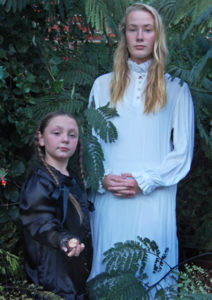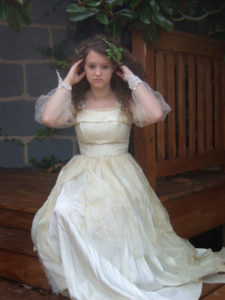 As the Gladys C. Burbage Courtyard Theatre grew into a beautiful performance space, Mrs. Lehman began to think that it was a shame to use it only once a year for performances. Since Fall on the Lower Eastern Shore of Maryland was known for its gorgeous weather, Mrs. Lehman decided to add an early Fall production that would be presented in the outdoor theatre.
As the Gladys C. Burbage Courtyard Theatre grew into a beautiful performance space, Mrs. Lehman began to think that it was a shame to use it only once a year for performances. Since Fall on the Lower Eastern Shore of Maryland was known for its gorgeous weather, Mrs. Lehman decided to add an early Fall production that would be presented in the outdoor theatre.
Adding an additional production to her schedule, she slated it for October, near Halloween, and assigned it to her Introduction to Theatre class. She decided they would present eerie, ghostly shows: one-acts that would run 45 to 55 minutes. The audience would be asked to bring their own chairs and blankets to sit on, and hot-mulled cider and warm gingerbread would be served to the audience after the show.

As Introduction to Theatre had Theatre History as one its main curricular elements, the Fall semester always began with a unit on story-telling and the “oral tradition.” Now, in conjunction with a “Halloween” show, students could be assigned research projects designed to generate ideas for original scripts. Students looked for ghost stories from the Eastern Shore and sometimes even wrote their own ghost stories. From their research and stories, Mrs. Lehman fashioned scripts. The very first of these original scripts was called “The Moonlit Road.” Every script after contained the word “moon” in its title, and thus, this production became known as the “moon plays.”

Presented annually on the Thursday and Friday before Halloween, the Halloween Moon Show remains a hit with audiences. Almost always a chill in the air, some years the temperature was surprisingly mild. Some years it was so cold patrons would scurry inside to grab a hot cup of coffee or mulled cider. The best weather years provided a full moon and fog, which certainly helped create an appropriate ambiance.
Mrs. Lehman’s scripts were always set in the nineteenth or early twentieth centuries, in small towns and villages, in remote areas, by rivers, or near the sea. Characters were mostly the same age as the actors playing them ~ younger teens and older adolescents. Following the Greek model, the audience never saw violence onstage, although the effects and/or aftereffects of violence were shown. These stories were never meant to be “horror” stories, but instead were ghost stories that sought to create psychological suspense and fear. They were also intended to create doubt in the audience, to lead audience members to question any supernatural explanations for events that were taking place. Meant to explore how humans would exploit one another for personal gain, her stories exposed human greed, human gullibility, human longing and betrayal, as well as the good that could triumph over evil.
